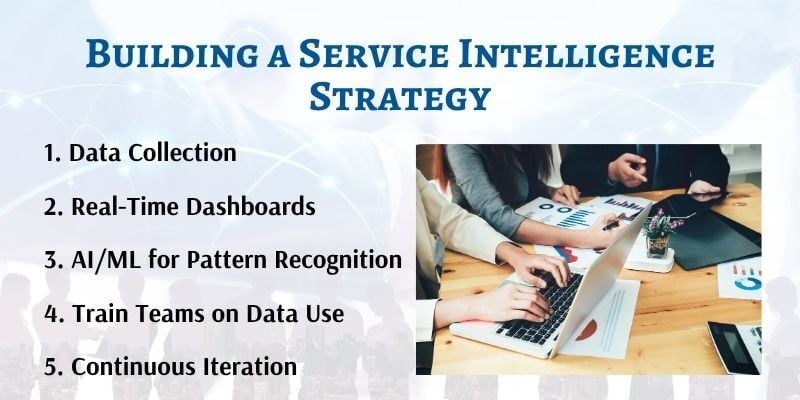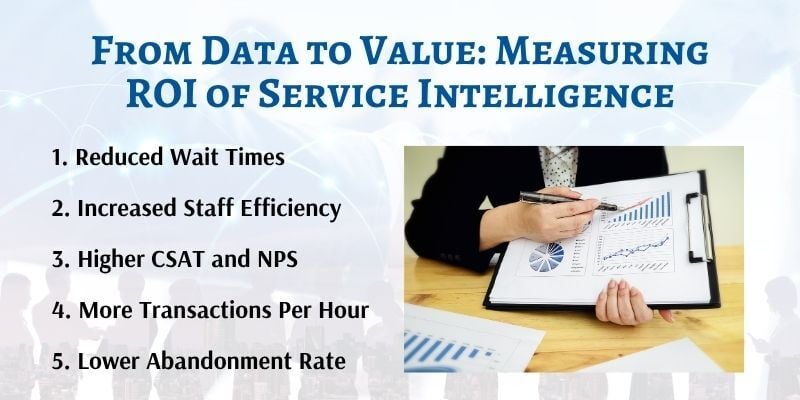A regional bank had a recurring problem. Long queues at some branches, idle staff at others, and customer complaints piling up.
Managers relied on spreadsheets and weekly reports to track performance, but by the time insights arrived, the damage was already done. Customers left frustrated, and staff felt helpless.
This isn’t just one bank’s story. It’s a familiar challenge for businesses that serve people daily and rely on physical locations to do it.
Whether you run a government office, a telecom franchise, or a healthcare group, keeping services consistent across branches is hard when you can’t see what’s happening in real time.
That’s where the idea of running a smarter business comes in.
In this blog, we’ll explore how service intelligence helps you run a smarter business by showing what’s working, what’s not, and where you need to act.
What is Service Intelligence?
Service intelligence is the practice of using real-time operational and customer service data to understand how effectively your organization is serving people across multiple locations.
For banks, government service centers, and other sectors, this means tracking live data, such as queue lengths, wait times, staff availability, and service volumes, to identify inefficiencies and take corrective action before they impact the customer experience.
Unlike traditional business intelligence systems that focus on historical trends, service intelligence provides visibility into current operations. This helps managers make timely decisions based on what is happening in the moment, rather than relying on delayed reports.
The goal is not just to collect data but to turn it into actionable insights. When service analytics are built around live performance and customer behavior, organizations gain a better understanding of both efficiency and service quality.
From managing high-traffic periods to reallocating staff where needed, service intelligence enables teams to make informed decisions that improve operational consistency and customer satisfaction.
Why Traditional Service Models Are No Longer Enough
Most organizations expected to deliver great service in person were built on outdated models. Customer expectations are rising rapidly, yet many service environments still lack real-time visibility, adaptability, and seamless data flow.
Even in well-run operations, managers often rely on manual methods such as periodic feedback forms, manual queue counts, and delayed reports. These reactive approaches create blind spots that lead to inefficiencies and missed opportunities.
Without service performance monitoring built into daily operations, businesses cannot respond swiftly to traffic spikes or staff shortages.
Managers are often caught off guard by bottlenecks and are unable to rebalance resources on time. The result is frustrated customers, long queues, and wasted staff capacity.
According to Deloitte, more than 53% of organizations expect a significant rise in service demand over the next few years. This makes outdated, reactive service models increasingly unsustainable.
Traditional workflows do not support proactive decision-making because they lack the real-time data needed to anticipate challenges. As expectations rise across industries, companies need a more responsive model that shows actual service performance, not assumptions.
How Service Intelligence Powers Smarter Business Decisions

Service intelligence turns operational data into actionable decisions. By capturing customer flow, interaction patterns, and service performance in real-time, organizations can continuously improve customer experience, branch design, and operational efficiency.
Below are four practical ways service intelligence supports smarter business outcomes:
1. Real-Time Queue Data
Understanding queue dynamics in the moment is crucial for maintaining efficient service. With Spectra, Wavetec’s real-time service intelligence platform, teams can monitor footfall patterns and queue lengths as they change, making it easier to deploy staff where they’re needed most.
This leads to faster response times, smoother customer flow, and fewer service delays without guesswork.
2. Customer Flow Insights
Analyzing flow patterns over time reveals where customers hesitate, wait, or disengage. Service intelligence systems track directional movements and touchpoints, highlighting structural inefficiencies in high-traffic areas.
These insights help teams redesign lobbies, counters, and waiting zones to eliminate friction and streamline service. Even small layout changes can significantly improve customer flow and reduce congestion.
3. Interaction History
Every visit, check-in, and transaction adds context to a customer’s service history. By using this data, teams can create a personalized customer experience that adapts based on preferences, past behavior, and service outcomes.
Feedback also matters. It helps refine these experiences by revealing what customers actually want.
As Bruce Temkin, co-founder of the Customer Experience Professionals Association, says: “Don’t waste customers’ time asking them questions unless you are prepared to act on what they say.”
This is not just a convenience; it’s a driver of growth. Companies with higher growth rates earn 40% more of their revenue from personalization than slower-growing peers, making it a clear strategic advantage.
4. Heatmaps, Dwell Time, and Volume Trends
Heatmaps and dwell-time analytics reveal exactly how people move through space and where they spend the most time. Combined with visit volume trends, these metrics show which areas perform well and which require intervention.
Service intelligence enables operations teams to fine-tune staffing, floor plans, and self-service points, ensuring smoother service delivery throughout the day.
Use Cases of Service Intelligence in Action
Service intelligence is not just a concept; it supports real-world improvements across multiple industries. Below are some practical applications where organizations have adopted a queue management system, digital signage, and kiosks to gather and act on real-time service data.
1. Retail
Retailers face intense pressure to deliver frictionless, engaging in-store experiences. By using real-time service intelligence, they can better manage queues, understand peak traffic times, and optimize store layouts.
A prime example is the FC Barcelona Megastore, where Wavetec implemented its linear queuing solution and digital signage. Facing long queues and peak season congestion, the Megastore needed a solution to improve customer flow and reduce churn.
Wavetec deployed a centralized queuing system across three floors, integrating people-counting cameras and live dashboards that provided visibility into queue lengths and waiting times.
Digital signage displayed estimated wait times and directed customers efficiently to open counters. This streamlined the checkout process and enhanced the overall shopping experience for thousands of daily visitors.
2. Banking
Banks need flexibility to adjust staff and counter availability in real time. Without up-to-date queue data, managers may be too slow to respond when lines build up, leading to delays and dissatisfied customers.
US Bank tackled this challenge by introducing digital check-ins and real-time branch monitoring to manage customer flow more efficiently. With better visibility into foot traffic, staff could adjust resources on the spot to reduce bottlenecks and wait times.
The result was a measurable drop in customer walkouts, faster service, and a noticeable rise in customer satisfaction across several branches.
3. Healthcare
Hospitals and clinics face constant pressure to manage patient queues efficiently without compromising the quality of care. Long wait times, fragmented communication, and unclear status updates can frustrate both patients and staff.
To address this, Nahdi Care Clinics in Saudi Arabia partnered with Wavetec to streamline their patient flow. By integrating Spectra API with their Hospital Information System, they enabled real-time WhatsApp notifications that kept patients informed from check-in to consultation.
Wavetec’s workflow-based ticketing, custom LCD displays, and WebTSU browser notifications ensured smoother transitions between triage and consultation. As a result, Nahdi Care reduced waiting times, improved operational efficiency, and achieved higher patient satisfaction.
4. Government Offices
Long lines, unclear wait times, and outdated processes often frustrate citizens seeking government services. These issues not only impact public satisfaction but also place pressure on staff and infrastructure.
The St. Lucie County Tax Collector’s Office improved this experience by implementing a digital queue management solution from Wavetec.
With appointment scheduling, virtual queuing, SMS notifications, and real-time dashboards, they streamlined foot traffic across three branches, reduced lobby congestion, and delivered a more transparent, efficient service experience.
Building a Service Intelligence Strategy

Delivering smarter, faster service requires more than technology. It starts with a step-by-step strategy, covering everything from data collection to real-time decision-making across banks, public offices, and service centers.
1. Data Collection
Begin by collecting data from self-service kiosks, ticketing systems, virtual queue entries, footfall counters, and feedback stations. Together, these data points provide a complete view of customer flow and interaction patterns.
A 2024 report from Forrester found that companies labeled as “customer‑obsessed” grow revenue 41% faster and profit 49% more than their peers. This highlights the power of using customer service data insights to enhance performance.
2. Real-Time Dashboards
Feed collected data into real-time dashboards showing metrics like queue length, average wait, counter availability, and walk-in versus appointment mix.
Managers can see these at a glance and react instantly. For instance, opening a new counter when the queue length crosses a threshold.
3. AI/ML for Pattern Recognition
Once data is collected at scale, AI and machine learning models can uncover complex patterns that aren’t visible through manual analysis. These models detect trends in service demand, predict footfall surges, and flag potential bottlenecks before they occur.
For example, AI can analyze historical ticketing and queue data to forecast peak hours or counter-specific slowdowns, helping teams proactively reassign staff or open extra counters ahead of time.
ML algorithms can also identify service types that consistently cause delays, enabling leaders to streamline those processes or provide pre-arrival instructions to reduce congestion.
4. Train Teams on Data Use
Staff must understand how to respond to data. When dashboards display service delays, frontline teams should know which actions to take, such as adding a counter, sending alerts, or reassigning staff.
Clear guidelines tied to specific metrics increase operational efficiency and consistency.
5. Continuous Iteration
Treat customer journey data as a live feedback loop. Instead of one-time audits, establish a structured review cycle, such as weekly or monthly check-ins, to analyze service metrics, including average wait times, abandonment rates, and resolution speed.
For example, PayPal continuously captures customer feedback across call centers and online channels, and routes that information in real-time to its service teams.
Feedback is assigned to the agents best positioned to act on it. This find-and-fix loop enables rapid performance improvements at scale.
Apply the same principle in banks, clinics, or government offices by piloting minor changes, such as new check-in flows, signage, or staffing schedules, and then monitoring the impact to refine accordingly.
This keeps operations nimble, effective, and rooted in actual behavior and service data.
From Data to Value: Measuring ROI of Service Intelligence

Service intelligence turns real-time operational data into better decisions, faster service, and measurable business gains. It’s not about more dashboards. It’s about smarter action at every service point, whether it’s a branch, kiosk, or mobile.
Below are five ROI outcomes organizations consistently see when they apply service intelligence across operations:
1. Reduced Wait Times
By tracking queue lengths and service durations in real-time, managers can take immediate action to reduce congestion. Systems like virtual queuing and automated appointment scheduling prevent bottlenecks and balance demand across time slots.
This results in a significant reduction in wait time and a more relaxed and organized experience for walk-ins. Consistently short wait times help reduce customer frustration and improve brand perception.
2. Increased Staff Efficiency
When footfall data and service demand patterns are visible, teams can be scheduled more strategically. For example, during low-traffic hours, fewer staff may be needed at the front desk, while high-demand times can trigger auto-alerts to bring in backup staff.
This helps reduce idle time, boost task load balance, and eliminate inefficiencies. Service intelligence also supports role optimization, so high-skill staff are only deployed when their expertise is required.
3. Higher CSAT and NPS
Personalized, timely service directly improves satisfaction metrics. With real-time visibility into queue status and wait conditions, staff can greet customers with awareness of their journey.
Feedback terminals and post-service surveys help track CSAT and Net Promoter Score (NPS) across service points, and sentiment analytics reveal trends by location or agent.
Service intelligence creates a data loop that enables faster corrective action, boosting loyalty and reducing churn. These insights are crucial for organizations aiming to improve business decisions related to customer experience strategies.
4. More Transactions Per Hour
By optimizing queue workflows and automating repetitive tasks, such as check-in or document validation, organizations can complete more service tasks within the same timeframe. This increases daily service throughput without increasing headcount or space.
In high-traffic branches, throughput gains of 15–20% are common. Queue optimization and efficient routing enable more customers to be served with less effort, directly supporting revenue goals.
5. Lower Abandonment Rate
Customers abandon queues when the perceived wait exceeds their patience. Service intelligence helps reduce this by providing accurate wait time estimates, sending real-time alerts when service is delayed, and offering digital queue options that allow customers to wait off-site.
Managers receive automatic alerts when queues grow too long or when walk-outs spike. Over time, queue abandonment rates drop as experiences become more predictable and responsive.
The Future of Intelligent Service Management
The next phase of service management is changing from efficiency-focused systems to intelligent operations that are data-driven, responsive, and customer-centric.
Organizations are moving away from siloed platforms to integrated ecosystems that combine customer experience automation, performance monitoring, and self-service into one fluid strategy.
A critical part of improving service operations is using customer service insights. Rather than relying on intuition or limited feedback, modern service providers analyze real-time data to understand wait times, resolution rates, agent productivity, and customer satisfaction across every touchpoint.
These insights help businesses preempt service failures, optimize staffing, and design experiences that meet users’ expectations from the start.
Additionally, customer experience platforms are now converging with workflow automation tools and digital engagement systems, enabling seamless escalation paths, predictive routing, and even automated service recovery.
Rather than treating service issues reactively, intelligent service management allows a proactive model: one that constantly improves, adapts to behavioral trends, and personalizes responses based on live data without needing manual intervention at every stage.
Conclusion
Service intelligence is not just about collecting data. It’s about turning that data into clear, timely decisions. When teams know exactly what’s happening across the service journey, they can prevent issues, respond faster, and create better experiences.
For organizations still relying on reactive service models, this is the moment to move toward smarter, more proactive operations.
Wavetec supports enterprises in making that move. Explore our service intelligence solutions or request a personalized demo. Our platform is designed to help you stay ahead of service challenges and consistently exceed customer expectations.
BOOK A FREE DEMO





